Current Trends in HPLC Column Technology
LCGC North America
The results of a recent survey on high performance liquid chromatography (HPLC) columns shows some interesting changes.
In this month's installment, we look at the results of a recent survey on high performance liquid chromatography (HPLC) columns, examining the trends in analytical and preparative column use and purchasing patterns since the last survey. Factors investigated in this study were mode and stationary phase usage, particle sizes and column dimensions, column budgets, and the factors influencing buying decisions. Column lifetime and use of guard columns also is considered. Future column buying plans were explored.
Biannually, LCGC surveys its readers to obtain a current profile of users of high performance liquid chromatography (HPLC). The last survey on HPLC columns was conducted in 2009 (1). In the past, I have used results from these surveys to chart trends in column technology and in the practice of HPLC. In late 2010, a web-based survey was sent to subscribers whose primary chromatography technique was HPLC. A total of 324 readers responded and this number was statistically sufficient to allow comparisons to previous survey data and to investigate trends.
To ensure that the results of the current survey were compatible with those of previous surveys, I used the same methodology to report the results. Because many of the questions allowed respondents to give more than one answer, in some cases, I normalized response totals. Normalizing the results to a base of 100% makes it easier to compare the results of previous surveys with those of the present survey and to identify trends in the use of HPLC columns, modes, and packings. Questions pertaining to mode usage, column lifetime, particle size usage, purchasing considerations, and possible future needs were explored to understand selection criteria.

Table I: Types of HPLC instruments used by survey respondents
Instrumentation Used
To understand the current usage rate of instruments, a question was asked pertaining to number and type of instruments personally used per respondent per week. Questions in previous surveys were less specific and, therefore, laboratory managers occasionally responded with estimates for their entire laboratory, which tended to skew the results. Table I shows the average response for each category of instrument. The numbers reported should not be construed to mean that every respondent uses every type of instrument; rather, they serve to provide an idea of the relative number of the various types of systems in general use. Later, I will look at the numbers of columns used by these instruments.
According to the survey results, a user of conventional HPLC instruments is responsible for a weighted average of 2.6 units. Because each respondent may have been responsible for a single instrument or for multiple instruments, this weighted average was derived from looking at the total number of instruments of this type identified by all respondents and then dividing this number of the total number of respondents. For example, some respondents reported that they have only one conventional HPLC system while others reported that they have five instruments for which they are personally responsible. Based on the relative numbers of Table I, for every one of these respondents that used a conventional LC system, only 1 in 16 would possess a capillary or nanoLC system; 1 in 4 might have an instrument dedicated to microbore columns; and 1 in 7 could have a preparative instrument in his or her laboratory. These numbers are slightly different from the 2009 survey (1), especially for conventional users, which was down from 3.6 per respondent (this was probably skewed by the laboratory manager contribution discussed above).
Mode and Phase Usage
Most liquid chromatographers use more than one chromatographic mode to solve specific separation problems. Because respondents were allowed to choose multiple modes, the total number of techniques used by respondents revealed that each used 3.2 modes on the average, in agreement with the last survey (1). This result doesn't mean that everybody is using all modes all the time, but that occasionally another mode may be used to solve a difficult separation problem. If one looks at the normalized data in Table II, which compares the relative mode usage in 1997, 2007, 2009, and 2011, it should be no surprise that the results again show that reversed-phase chromatography was, by far, the most popular mode; according to the raw data, more than 93% of respondents use this mode and normal bonded phase usage was a distant second with 31%. These data have been corrected for those using ion pair chromatography (a subset of reversed-phase chromatography) and cyano columns for reversed-phase work. In earlier surveys, cyano columns were presumed to be mainly used in normal-phase separations, but this survey revealed that the predominant use of CN columns was in reversed-phase chromatography where this phase serves well as a short chain phase with unique selectivity.

Table II: Analytical HPLC mode and stationary phase usage
Although the data in Table II show that reversed-phase chromatography has dropped on a relative basis, this drop is not caused by its decrease in popularity (which remains extremely high), but rather results from the increased use of other modes such as chiral and hydrophilic interaction chromatography (HILIC). HILIC, where respondents indicated a doubling in usage since 2007, is a separation technique for highly polar analytes that gets around some of the problems associated with reversed-phase chromatography, such as low retention or phase collapse (dewetting). HILIC uses a polar stationary phase such as bare silica gel, polar bonded phases (for example, diol), or specialty phases with dual functionality and requires a high percentage of a nonpolar mobile phase, usually acetonitrile, similar to the requirements for normal-phase chromatography. However, unlike normal-phase chromatography, which uses nonpolar solvents like hexane and methylene chloride and tries to exclude water from the mobile phase, HILIC requires some water in the mobile phase to maintain a stagnant enriched water layer on the packing surface into which analytes may selectively partition. In addition, water-miscible organic solvents are used. Under HILIC, polar analytes are well retained and are eluted in order of increasing hydrophilicity. Bare silica, specified for adsorption chromatography in the survey, is still a widely used HILIC phase, but the current survey did not explore its use in HILIC applications.

Table III: Stationary phases used in reversed-phase chromatography
Supercritical fluid chromatography (SFC), which employs columns similar to those used in HPLC, also has seen renewed interest, especially for preparative chiral separations. The use of chiral columns in SFC was not explored in the present survey, although a few respondents "wrote in" their use of HPLC columns in this increasingly popular chromatographic mode.
The use of ion-exchange chromatography showed a slight upward swing in usage and is back to its historical levels. Included in this usage is ion chromatography, which is sometimes treated as a separate separation technique but in reality is ion-exchange chromatography because it employs the same separation principles and uses columns with ionic or ionizable functionalities. Ion-exchange chromatography is frequently used in proteomics where a large number of tryptic peptides are fractionated by 2D LC first with ion exchange followed by reversed-phase chromatography–mass spectrometry (MS) for separation and detection. It also finds use in amino acid separations and protein purification protocols. Although ion-pair chromatography also separates ionic and ionizable compounds, it is generally lumped with reversed-phase chromatography because it employs the same packing materials. Many chromatographers familiar with reversed-phase chromatography prefer to use ion-pair chromatography for ionic and ionizable compounds because the columns are more familiar to them and the principles of reversed-phase chromatography can be generally applied in method development.
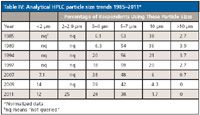
Table IV: Analytical HPLC particle size trends 1985â2011*
The normalized data in Table III further break down the reversed phases into individual organic moieties and clearly show that C18 (octadecylsilane) was most popular (the raw data showed that 92% of all users use this phase at some time) followed by C8 (octylsilane). The use of phenyl-bonded phase has showed steady usage as chromatographers exploit its unique selectivity compared to alkyl phases. The phenyl-hexyl and diphenyl phases that have seen some interest were not explored this time, but they will be included in future surveys. For the first time, I expanded the survey to include fluorinated phases that 14% of respondents mentioned that they have tried for separations where the conventional reversed-phase chromatography materials didn't do the job. In addition, graphitized carbon was added in this year's survey; only 4% of respondents indicated that they had tried this specialized material that is one of the more rugged reversed-phase packings. Again, just as in 2009, cyano phases used in aqueous solution showed quite strongly in the survey as a bonafide reversed-phase packing.
Particle Sizes in Analytical and Preparative LC
Since the beginning of HPLC in the late 1970s, the trend has been to use columns packed with smaller spherical particles. Throughout most of the 1970s, 10-µm irregular particles were the norm because they were commercially available and slurry packing column efficiency was quite good. In the late 1970s, 5-µm spherical particles gave better performance because of improved mass transfer and better packing ability. Through occasional LCGC column surveys, I started tracking particle size usage in the mid-1980s. Table IV provides data of the use of various particle sizes from 1985 until 2011 (current survey). As one can see from the first survey, columns packed with 10-µm particles had already given way to 5-µm particles. These particles maintained their dominance through the 1990s and are still in widespread use today. There are many validated methods that have been developed on 5-µm particles, and users don't want to take the time to revalidate their method unless there is a strong driving force to do so. Nevertheless, as can be seen in Table IV, the use of even smaller particles (<2–4 µm) began in earnest in the mid-90s and now these particles have caught up and surpassed the 5-µm particles. With the reduction in particle size, column efficiency improved further allowing a reduction in column length. Shorter columns are now in vogue. Not only does a shorter column provide faster separations but solvent use is reduced. Recently, the use of sub-2-µm particles has become fashionable in even shorter column lengths. In just a short time, the use of the sub-2-µm columns has doubled. Columns of 30–50 mm in length packed with these particles now provide plate counts formerly obtained on 15- and 25-cm columns packed with larger particles.
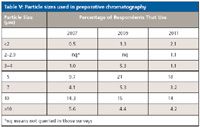
Table V: Particle sizes used in preparative chromatography
In the current survey, we queried the use of 2–3 µm porous particles that have attracted the interest of some users. These columns are intermediate between the popular 3.0–3.5 µm columns and the newer sub-2-µm columns. They show lower pressure drops and efficiency than the sub-2-µm particles but better efficiency and higher pressure drop than the 3.0–3.5-µm particles. Since the last survey, the increasing use of the superficially porous particles (SPP) (also referred to as solid core, core–shell, and the like) has taken place. Even though the question for the survey was based on use of porous particles, I suspect that the respondents also took into account their increased use of SPP particles because the number reported in Table IV was quite high for the relative usage of 2–2.9 µm particle columns. The SPP columns (with particle sizes of 2.6–2.7 µm) have quickly become a partial substitute for the sub-2-µm columns because they offer similar efficiency at half the pressure drop. Hence, users of conventional HPLC equipment can take advantage of ultrahigh-pressure liquid chromatography (UHPLC) separation capability.

Table VI: Top five column dimensions used in analytical HPLC
In comparing the use of preparative chromatography to analytical HPLC, 62% of those performing analytical separations do not use preparative chromatography. Not surprisingly, those that perform preparative separations tend to prefer larger particles as depicted in Table V. Reasons for the preference of larger particles (10-µm and higher) are lower cost, lower pressure drop, and loadability. For the latter consideration, the higher efficiency of smaller particles may be lost when overloaded conditions are employed. Even so, in the present survey, there has been an increase in respondents using smaller particles for preparative work (Table V). For example, 18% of respondents use 5-µm particles for their preparative work, up from 9.7% in 2007.
Column Lengths and Diameters in Analytical HPLC
In this year's survey, we included a question about column lengths and diameters used in analytical HPLC. For many years, when 5-µm particles were dominating analytical work, 25 cm × 4.6 mm columns were the standard but now the 15 cm × 4.6 mm column is the "workhorse" dimension. Table VI provides the top five column dimensions chosen by survey respondents. The rise of 2.0–2.1-mm i.d. columns in 50- and 100-mm lengths undoubtedly results from the widespread acceptance of LC–MS, in which flow rate requirements of MS inlets require smaller inner diameters. The 3.0-mm i.d. columns are a good intermediate size that allows the use of conventional LC equipment, yet saves solvent because of smaller flow rate requirements compared to 4.6-mm i.d. columns.

Table VII: Types of analytical columns used by respondents (weighted average)
Column Purchase Patterns
Several questions in the survey related to the purchase of analytical HPLC columns on a per instrument basis. Most of the respondents purchase prepacked columns and very few purchase empty columns and bulk packings, presumably to pack their own. More than 90% of respondents have no budget for empty columns or bulk packings. After prepacked analytical columns, the largest expenditure is for guard columns. About a third of respondents have no budget for guard columns, but for those that do, the average guard column expenditures are about half of those of the average analytical column budget.

Table VIII: Sources for HPLC column procurement
The average annual purchase budget for prepacked analytical HPLC columns per instrument was approximately $2890, about 5% lower than the last survey results (1). For the respondents that do purchase guard columns, the average budget was about $1650. The average cost of a guard column is $80, so this would amount to approximately 20 guard columns per instrument per year or about three guard columns per analytical column (again not an unreasonable number). Guard columns extend the life of analytical columns; therefore, without these expenditures, users would have to allocate a higher percentage of their budget for prepacked columns.
Another question broke down the purchases of different dimensions of LC columns. Users were asked about their yearly purchases of conventional analytical columns (3.0–4.6-mm i.d.), microbore columns (2.0–2.1 mm i.d.), narrow-bore columns (1.0-mm), and capillary columns (less than 1-mm i.d.) on a per instrument basis. Table VII shows the column units used based on a weighted average. For conventional HPLC column users (3.0–4.6 mm i.d.), an average of 7.4 columns per instrument per year are used, up from 5.8 in 2009 (1). Microbore columns that also can be used on some conventional analytical instruments and all UHPLC instruments and are the mainstay of LC–MS users averaged 5.3 columns/year per instrument, up double from the 2009 survey. UHPLC favors the use of microbore columns because of frictional heating effects displayed by large internal diameters and pump flow rate limitations at very high pressures (1000 bar) for some UHPLC systems. In addition, the rise in the use of LC–MS, which favors microbore columns, has helped to spur their growth. One would expect narrow-bore and capillary columns to have lower usage based on the smaller number of available instruments that accommodate these smaller internal diameter columns (see Table I).

Figure 1: Column failure problems.
One of the questions asked chromatographers from which source they prefer to purchase prepacked HPLC columns. According to the survey (see Table VIII), the chromatography supply houses have increased their lead, mainly driven by the stronger presence of one manufacturer. A continued drop off in share was noted for the general laboratory suppliers. This year 18% of the users surveyed purchase their columns from this source, a drop of 25% from 2009 (1). General laboratory distributors usually provide less technical assistance than the dedicated chromatography suppliers or instrument manufacturers, but they promote themselves as one-stop shopping where users can get solvents, chemicals, and laboratory glassware, as well as HPLC columns. The general laboratory distributors sometimes provide additional services such as electronic ordering, local stocking, volume discounts, and on-site services. The percentage of users loyal to their own instrument manufacturer has slipped a bit in favor of consideration of purchasing columns from any instrument manufacturer, whose ranking is flat compared to earlier surveys (Table VIII). According to the present survey, a further dropoff in share was noted for the independent column manufacturers who had seen a substantial rise in their share of the HPLC columns' market in the last survey (1). Surprisingly, a few more people are packing their own columns, perhaps driven by the faltering economy.
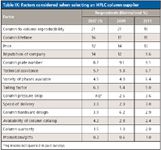
Table IX: Factors considered when selecting an HPLC column supplier
Table IX lists, on a normalized basis, the factors that respondents considered important when purchasing an HPLC column. Respondents were asked to name the top three factors that influenced their buying decisions. The most important factor — ranked the same in earlier surveys — is column-to-column reproducibility. Nobody wants to develop a method only to find out that the column that they purchase later for the same application does not perform in the same manner. However, column reproducibility has definitely improved over the years, driven by competitive pressure, quality initiatives such as ISO and 6-Sigma, and a better understanding of the manufacturing processes. The next factor was column lifetime, an issue that will be explored in more depth in the next section. In this survey, taken during one of the worst economic global turndowns in the Western world, price was rated the third most important factor in considering a column supplier, while the company reputation remained in fourth place. The remainder of the factors showed that some variations with column hardware design are considered less important than previously reported, but a variety of phases, speed of delivery, and technical assistance of the supplier gained in importance.
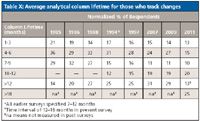
Table X: Average analytical column lifetime for those who track changes
Column Lifetime
As mentioned earlier, column lifetime is an important selection and operating parameter in HPLC. This survey specifically explored column lifetime from two standpoints — lifetime in months and by the number of injections. Although some modern liquid chromatographs track the number of injections, many chromatographers do not. Usually, one will install an HPLC column and keep it in the instrument, performing one or more methods until the column shows a loss of resolution or shows significant tailing that may affect quantitation. Chromatographers may track the time of usage in a logbook.
The first question that was explored was as follows: What does one see as the failure mode when a column is considered "dead"? Respondents were given a choice of eight column problems that are normally considered to be signs of a failing column. Figure 1 shows a bar graph that depicts the responses for each symptom. Of course, some of the symptoms are related. For example, broadened, tailing peaks manifest themselves as loss of column efficiency, but the most important warning that a column may be failing is a high back pressure followed closely by loss of efficiency. High back pressure may be a problem with the column packing but sometimes it is associated with plugging the inlet frit with foreign matter. Retention time changes can sometimes be related to a loss of stationary phase, an upset of the column equilibrium, or pump problems. Rarely does a column show an erratic flow rate when failing; flow rate changes are most often associated with the pumping system. Other written-in responses for characterizing a "dead" column were peak splitting (doublets); results outside of method specification, standard mix doesn't pass, system suitability requirements not met (which are all related); loss of resolution; appearance of ghost peaks; and high RSDs of replication injections.

Table XI: Percentage of respondents who reported on column lifetimes by the number of sample injections for analytical columns
As shown in Table X, since the earliest days the observed analytical column lifetimes have continually increased through the years. I first began asking about lifetime in column surveys in 1985, 21% of the respondents had columns that lasted less than three months. Now only 13% of respondents' columns have lifetimes of less than three months. If one looks carefully at the data of Table IX, nearly 19% of the respondents now experience column lifetimes of at least a year and a whopping 43% have columns that last at least up to 18 months, some beyond. About 17% of the users don't track column lifetime by month at all. It is surprising that with such long lifetimes now being achieved that users are still requiring more than seven new columns a year for each of their instruments so other factors must be influencing their purchase, such as an increased volume of samples or procurement of improved columns.
When the question was asked about column lifetime based on the number of injections, a larger number (30%) of the respondents reported that they do not track their injections. Table XI shows the data of those who do monitor column lifetime based on the number of injections. There has been a definite trend in columns surviving more injections over the last few years, especially comparing the data from 1997 to 2009. Some of this increase is because of chromatographers becoming more aware of the limitations of silica-based HPLC columns, using specialty high and low pH columns, and exploring polymeric and other column types that are more rugged. In Table XI, only 20% of the respondents get less than 500 injections from a typical analytical column while 30% get up to 1000 injections and 20% get more than 1500 injections.
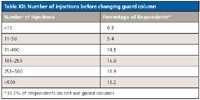
Table XII: Number of injections before changing guard column
Although the data are not shown in the table, a large percentage of preparative column users do not track monthly column lifetime (62%) nor do they track the number of total samples injected (74%) before discarding a column. Intuitively, one would think that preparative columns would have shorter lifetimes because they tend to be used for dirty samples, at high flow rates, and with higher sample loads than analytical columns. Surprisingly, those few respondents using preparative columns that do track lifetime reported that more than 60% of their preparative columns last longer than a year. This greater lifetime perhaps indicates that preparative columns are used less frequently than analytical columns and therefore tend to be stored and used at a later date when the need for preparative applications arises. Another possibility for longer lifetimes would be that preparative columns are substantially more expensive than analytical columns and users may take better care of them. A third possibility is that the larger particles used in preparative chromatography do not generate as high a back pressure as obtained with the smaller particle analytical columns. Higher back pressure tends to limit the column lifetime because more stress is placed on the column materials.
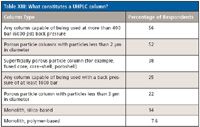
Table XIII: What constitutes a UHPLC column?
Use of Guard Columns
One way to increase the lifetime of an analytical or preparative column is to use a guard column to protect it from chemical or mechanical interferences. I have explored the use of guard columns in the present survey. Although guard columns have proven to cut the overall costs of analytical columns, 36% of respondents do not budget for guard columns and 31% do not use guard columns at all. As reported earlier, on the average, about 20 guard columns are used per instrument per year. Table XII shows the breakdown of responses for those who use guard columns, when asked about how often they change their guard column. Based on these responses, one can estimate that an average user changes the guard column after 280 injections. Depending on the sample cleanliness, this may or may not be often enough. Normally, it is somewhat of a "trial and error" procedure to determine when a guard column should be replaced.

Table XIV: Types of columns that will be tried in future
Future Column Interests
In recent years, many new column types have come onto the market. A column renaissance has been taking place with new formats and new phases. However, most users are still employing traditional columns. I thought it would be worthwhile to pose a question on which of the newer columns will they try in the future.
There seems to be some confusion as to what the term UHPLC actually means. So respondents were given a number of choices as to what they thought constituted a UHPLC column. Table XIII shows the breakdown by percentage of respondents. A majority of respondents believed that columns that operate at pressures greater than 400 bar (6000 psi) or columns that have sub-2 µm particles are considered a UHPLC columns. But superficially porous particle columns were considered as UHPLC columns by 38% of the respondents even though these columns show remarkably low back pressure. Only 25% of the respondents felt that the very-high-pressure columns with 1000-bar capability defined a UHPLC column.
Next, in the present survey, interest in five column types that have come out on the market was queried. A question was posed about which of the newer technologies users might try in the future. The respondents were asked to prioritize the column types. The first priority in each category is shown in Table XIV and provides a comparison of the raw responses. Clearly, the particles that were considered to be UHPLC packings (Table XII) were the top choices. Monoliths still haven't gained much traction in the marketplace but respondents did show some interest in investigating them in the future. Future interest in monoliths is considerably stronger than in the last survey (1).
When asked why they would try one of these newer column technologies, written-in responses included faster separations or higher sample throughput, development of better methods or better resolution, more plates, better peak shape, lower solvent consumption, lower pressure, different or better selectivity, adaptability to conventional HPLC system, run at higher pH, new UHPLC instrument, and (my favorite) a free sample.
Conclusion
This survey has shown some changes in HPLC and UHPLC column usage over the time period selected. As expected, reversed-phase chromatography maintains its dominance with 93% of respondents using this technique with C18 and C8 being the most popular phases but with new chemistries such as fluorinated and phenyl phases showing some growth. I asked about the frequency of use of cyano columns in the reversed-phase mode, and, not surprisingly, the use of this phase in reversed-phase chromatography is much stronger than in normal-phase applications. By far, the biggest growth has been in the HILIC area, which has more than doubled during the last four years. Although not directly queried, the greatly increased use of bare silica columns further indicates that HILIC is becoming a well-accepted alternative to reversed-phase chromatography for polar analytes.
The use of smaller particles is evident with the sub-3.0-µm particles gaining in popularity and now surpassing the use of the always popular 5-µm porous particles. The use of sub-2-µm columns has remained strong since the last survey, coinciding with the acceptance of UHPLC. These smaller particles are usually packed in shorter columns and run at higher flow rates, but longer columns dictate the higher pressures of UHPLC. Superficially porous particles have gained in popularity and presumably showed up in the 2–2.9-µm category along with comparably sized porous particles; they have the efficiency of the sub-2-µm particles at half the pressure. In terms of column dimensions, 15 cm × 4.6 mm has now been established as the most popular column size and 2.0–2.1 i.d. columns have been popularized by the widespread acceptance of LC–MS.
Column purchasing questions revealed that column budgets have decreased by 5% compared to the 2009 survey while usage for analytical columns has grown slightly to a weighted average of 7.4 per conventional analytical instrument per year. In terms of procurement, the general laboratory distributors have lost a portion of the market taken up by chromatography supply houses. Column-to-column reproducibility is still the top factor in the buying decision, but column lifetime maintains a strong second position in buying factors.
Column lifetimes for both analytical and preparative chromatography have remained strong and continue to increase; the increased use of guard columns and more stable phases has helped. Future column interests include the SPP columns and the sub-2-µm UHPLC columns to go along with the newer UHPLC systems coming onto the market. Silica and polymeric monoliths continue to get minimal attention in most laboratories, although future consideration was noted.
Ronald E. Majors
"Column Watch" Editor Ronald E. Majors is Senior Scientist, Columns and Supplies Division, Agilent Technologies, Wilmington, Delaware, and is a member of LCGC's editorial advisory board. Direct correspondence about this column via e-mail to lcgcedit@lcgcmag.com.

Ron Majors
References
R.E. Majors, LCGC N. Amer. 27(11), 956–972 (2009).
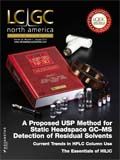
New Study Reviews Chromatography Methods for Flavonoid Analysis
April 21st 2025Flavonoids are widely used metabolites that carry out various functions in different industries, such as food and cosmetics. Detecting, separating, and quantifying them in fruit species can be a complicated process.














